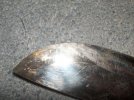how far back is the ding? the blades are hardened/tempered by heating them then cooling the edge with a teapot of boiling water, so results depend on the skill of the kami and a bit of luck. the tip is usually not hardened much to keep it from snapping if it hits a rock, the inside, concave curve is usually not hard, only the 'sweet spot' in the convex part of the blade where you normally strike is hardened.
a pic of the blade with a magic marker indicating the location/extent may show up better. some people have found that the steel is actually a bit harder under the 'skin' and sharpening out small dings can improve the hardness. steeling the edge with the chackma can straighten out small dings & harden the edge. the kamis do however sometimes get it wrong, especially around the holidays. if it's a large deformed area that cannot be steeled or sharpened out, you may want to have a word with the boss lady.
people here are fond of etching the blades with vinegar or lemon/lime juice (from fruit, not bottled) which shows the heat treated area & also makes the blade look cool.

